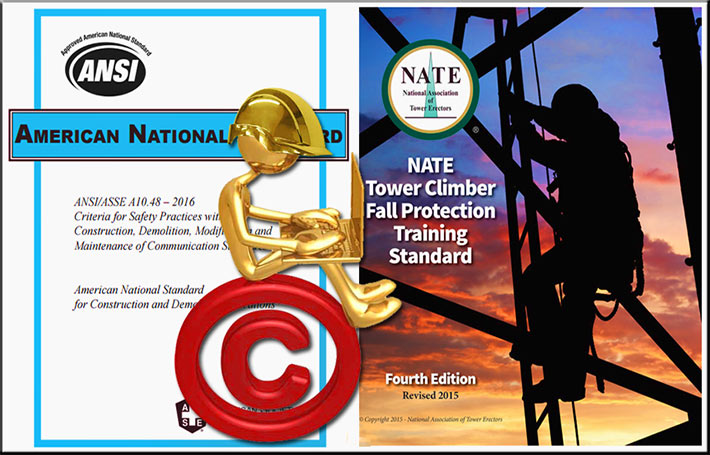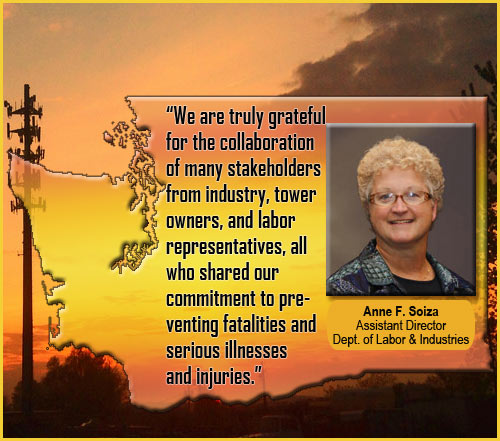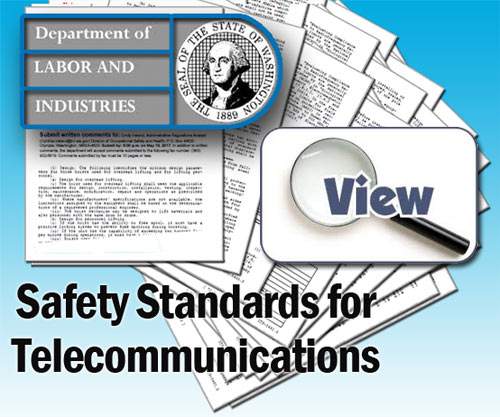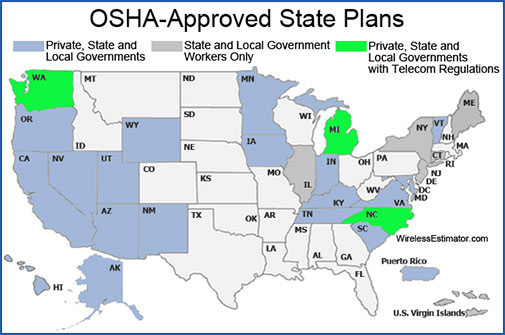
The State of Washington Department of Labor and Industries (L&I) adopted their Safety Standards for Telecommunications, Chapter 296-32, on Monday with a Jan. 1, 2018 effective date for the comprehensive 106 pages of rules.
Industry associations had challenged some of the major inclusions, but the final version released yesterday saw mostly definition changes, and clarity revisions that do not require additional public review and comments.
 The L&I rule includes requirements for rigging plans, gin pole installation, use and inspections; base mounted hoist requirements, and helicopter lifting requirements from ANSI/ASSE A10.48. The standard also added requirements from ANSI/TIA 222G.
The L&I rule includes requirements for rigging plans, gin pole installation, use and inspections; base mounted hoist requirements, and helicopter lifting requirements from ANSI/ASSE A10.48. The standard also added requirements from ANSI/TIA 222G.
Although there had been partial rule changes from 1976 through 2002 to Chapter 296-32 the adopted revision began in 2013, when the L&I received petitions formally requesting the department to recommence with the rulemaking that began in 2009.
They scheduled additional stakeholder meetings starting in May 2015, and throughout this process the department worked with labor, business, and industry representatives to develop the new proposed rule.
Three public hearings on the standard were held in May and written comments were required to be submitted by May 19, 2017.
NATE, others unsuccessfully fought inclusions
Whereas OSHA publicly provides commenters’ concerns or statements as they are provided, such as in an RFI for Communication Tower Safety in 2015 or rulemaking proposals, L&I is not required to present them in advance of an adoption if L&I is not considering or making major changes to the proposed standard.
Those comments were released yesterday and show a divide between Washington regulators and industry standards rulemaking groups, the National Association of Tower Erectors (NATE) and others.
Some commenters said they believe that there are currently enough safety standards available and a new one could confuse people in the field regarding what regulations they should use to be compliant.
Copyright infringements alleged
L&I does not provide the names of individuals or organizations that are commenting, but it appears that NATE or its representative was concerned about L&I using information from their climber training standard.
 “I want you to know that the NATE tower climber training standard was copied, and it is copyrighted materials, and only portions of it were used. And as a copyrighted material, I would tell you that NATE is prepared to make a vigorous defense of any use of a portion of that standard without our permission,” the commenter said.
“I want you to know that the NATE tower climber training standard was copied, and it is copyrighted materials, and only portions of it were used. And as a copyrighted material, I would tell you that NATE is prepared to make a vigorous defense of any use of a portion of that standard without our permission,” the commenter said.
The 103-page NATE Tower Climber Fall Protection Training Standard was revised March of 2015.
L&I replied that members of other industry consensus standard committees attended development meetings and “no copyright issues were ever brought up at a stakeholder meeting by members of any industry consensus standard committee.”
L&I said that there were no areas where the Washington State rule conflicts with industry consensus standards “…and there are no gaps when these rules and consensus standards are compared side by side.”
A commenter that appeared to be representing an industry association said that they had staff conversations with the American Society of Safety Engineers (ASSE), who is part of the developer of the A10.48 standard, and the ASSE “revealed that they are also prepared to make a vigorous defense of any partial use of a standard that is legally copyrighted material.”
L&I replied that several members of the ANSI 10.48 committee attended their rulemaking meetings and worked with them with their requirements for rigging plans, gin pole use, fall protection equipment, climbing hardware and other areas, and the proposed language was a result of their input.
“None of those organizations contacted the department during the public hearing comment period with concerns of any potential copyright issues,” L&I said.
The new rule references ANSI/TIA 222-G numerous times, but it appears that the only content from the structural standard for antenna supporting structures and antennas is the inclusion of inspection intervals for towers.
Wireless Estimator was not able to reach the State of Washington’s Office of the Attorney General to identify whether they investigated copyright concerns before L&I approved the regulations.
It is not known if copyright infringement charges will be made by NATE or ANSI.
One commenter said the telecommunications industry is already subject to specific and complete standards regarding crew safety and those best practices have been adopted after extensive research and development in cooperation with multiple stakeholders. They said, “These standards include ANSI/ASSE A10.48, ANSI/TIA-322, and the National Association of Tower Erectors’ training guidelines and standards.”
L&I disagreed, stating, “We believe the proposed rule clarifies the requirements and does not conflict with other safety and health rules enforced by DOSH. Great efforts were made by the department and key industry experts to avoid conflicts or confusion with national consensus standards. Cross-references were made to verify that no conflicts existed between ANSI and this rule.”
L&I said ANSI/ASSE A10.48 has not been adopted as a rule and it is not enforced by any state or by OSHA. “Much of the information in it is recommended or a suggested best practice,” they said.
However, L&I can enforce compliance with ANSI/ASSE A10.48 and cite companies with violations because they state in their standard that workers “must’ comply with the telecommunications construction standard.
Comments provided to L&I can be reviewed here.
Representatives from T-Mobile, AT&T, Verizon, telecommunication tower owners, telecommunication tower construction companies, International Brotherhood of Electrical workers and Communication Workers of America participated throughout the rulemaking process.
 L&I pleased to lead the country with its rule
L&I pleased to lead the country with its rule
“With the adoption of this telecommunication rule, we are extremely pleased that Washington State leads the country in protecting this industry’s workers’ lives as profound changes in industry practices are occurring,” Anne F. Soiza, L&I Assistant Director, informed Wireless Estimator today.
“We are truly grateful for the collaboration of many stakeholders from industry, tower owners, and labor representatives, all who shared our commitment to preventing fatalities and serious illnesses and injuries,” said Soiza.
OSHA hasn’t registered any concerns
Twenty-six states plus Puerto Rico and the Virgin Islands have OSHA-approved plans, with 21 states and one U.S. territory covering both private and state and local government workplaces.
States must meet all federal regulations, but can exceed them, as is the case with the more stringent Washington rule.
Whereas state and federal regulations frequently refer to consensus standards for suggested compliance, Washington most oftentimes states that workers “shall” or “must” comply with each requirement, allowing for strict and manageable enforcement by its Occupational Safety and Health inspectors when violations become known.
OSHA has reportedly been apprised of Washington’s rule adoption and has not registered any concerns regarding the new standard.
According to a cost-benefit analysis report for the telecommunications standard obtained by Wireless Estimator, L&I estimates that the rule amendments would impose total costs on all affected parties in Washington within a range of $103,697 to $216,866 each year. The estimated total benefits of their amendments would range from $1.50 million to $2.12 million annually.
Median hourly wages used in the analysis were: Telecommunications Equipment Installers and Repairers (except Line Installers), $27.76; Telecommunications Line Installers and Repairers, $23.49; Radio, Cellular, and Tower Equipment Installers and Repairers, $29.53.
Washington is the third state to adopt a telecommunications rule following Michigan and North Carolina’s lead.
A number of other states are also reviewing Washington’s regulations for possible adoption, according to individuals knowledgeable of their plans.
















